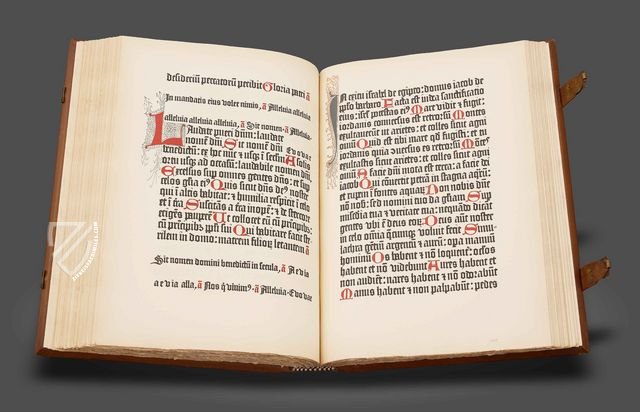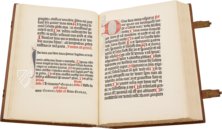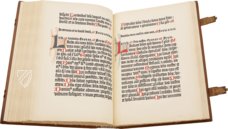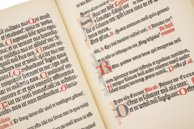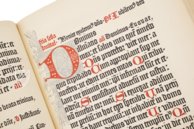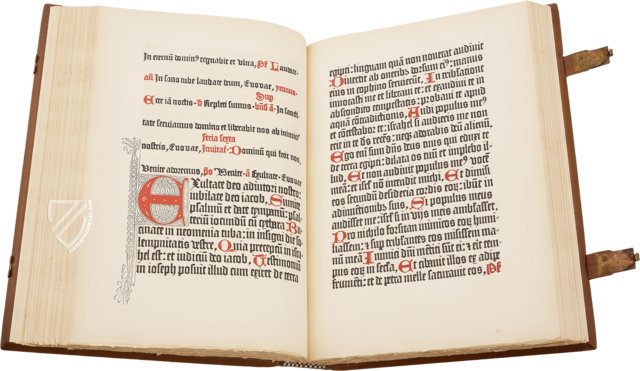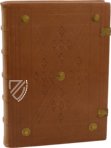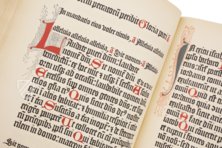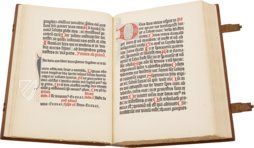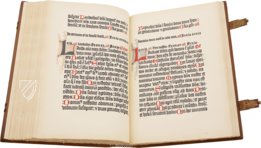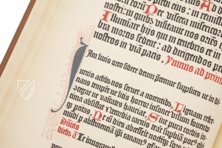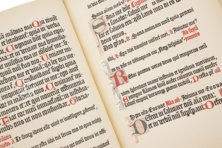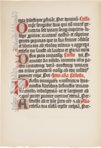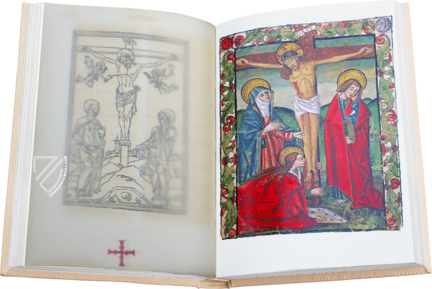Mainz Psalter
Commissioned by the Archbishop of Mainz in 1457, the Mainz Psalter is the second major printed book following the Gutenberg Bible. It was created by two former associates of Johannes Gutenberg, Johann Fust and Peter Schöffer, and was the first publication of their new studio. The work represents many firsts in the history of book printing: it was the first book to have a printed colophon with the date, printer (Schöffer), and publisher (Fust) as well as two sizes of type, printed decorative initials, and is the first book to be printed in three colors – black, red, and blue. Its text is printed in black and red and has numerous red and blue woodcut initials, but the technique was abandoned soon thereafter because the setting and resetting of the different colored types was too time consuming. The Mainz Psalter thus represents a rare example of this process and most early printed works continued to leave blank spaces for artists to draw initials and other decorative elements by hand. 13 copies of the printed book on vellum are known to exist today, including this specimen from the Austrian National Library.
Mainz Psalter
The second book published after the invention of Gutenberg’s printing press with moveable type is arguably more significant for the history of book printing than the first due to the number of innovations that it introduced, which are standard today. Printed on vellum in 1457 at the behest of the Archbishop of Mainz, this historically significant Psalter is a marvelously designed work that also features innovations that were abandoned, at least for a time. The history of the printing house that created it also reveals the details of the financing of the world’s first printing house and how the partnership that created it ultimate broke up and resulted in a court case. Thus, the Mainz Psalter is considered to be a precious witness to the incunable period, the genesis of book printing.
The First Colophon
The Mainz Psalter is the first book to have a printed colophon with information that includes the date as well as identifying Schöffer, who actually carried out the printing, and Fust, who ran the business side of things as the publisher. Printed in red ink with a large blue “P” initial with red filigree décor at the end of the codex, the colophon also features the first printer’s mark in history, which consists of two shields suspended from a branch, also printed in red. Written in Latin, the colophon explains how this revolutionary codex came to be:
“This volume of the Psalms, adorned with a magnificence of capital letters and clearly divided by rubrics, has been fashioned by a mechanical process of printing and producing characters, without use of a pen, and it was laboriously completed, for God's Holiness, by Joachim Fust, citizen of Mainz, and Peter Schoeffer of Gernsheim, on Assumption Eve [August 15] in the year of Our Lord, 1457.”
An Experiment in Multi-Colored Printing
This is the first book to be printed in multiple colors. In order to create multicolored prints consisting of black text with some small red initials and large blue-red initials, the elements that were to be printed in color were individually removed from the typesetting, colored separately, and reinserted before pressing. Although this was already possible with the rudimentary printing presses of the 15th century, it was an expensive and time-consuming process that was abandoned by contemporary printers and not readopted until technology advanced. In the meantime, the vast majority of printed books, including the Gutenberg Bible, left blank spaces for initials to be hand drawn by an illuminator along with any other adornment according to the tastes of the patron. As a result, the Mainz Psalter is one of the only examples of early attempts at multicolored printing.
Fust v. Gutenberg
In order for Johannes Gutenberg (ca. 1400–68) to get his printing enterprise off the ground, he needed financial backing, which he got in the form of a loan – 800 guilders in 1450 and a another 800 in 1452 – from the goldsmith, lawyer, and money lender Johann Fust (ca. 1400–66). Their business relationship was further cemented when Fust’s future son-in-law, a scribe who was trained in Paris named Peter Schöffer (ca. 1425 – ca. 1503), was taken on as a printing apprentice and helped design some of the first typefaces.
However, a dispute broke out between Fust and Gutenberg in 1455, the same year the famous Gutenberg Bible was first printed, and as a result Fust sued Gutenberg in court for the 1,600 guilders he was owed plus 6% interest for a total of 2,026 guilders. Schöffer testified on Fust’s behalf and the suit was decided in Fust’s favor on November 6, 1455, giving him control of the workshop and half of the unsold Bibles. He supposedly took the some of the presses and started his own printing house with Schöffer, although there is no concrete evidence for this. It is still debated whether Fust was a patron and benefactor who may have actually instructed Gutenberg and was merely trying to recover his investment, or a scrupulous speculator who robbed Gutenberg of the profits of his invention.
Codicology
- Alternative Titles
- Mainzer Psalter
Der Mainzer Psalter von 1457 - Size / Format
- 350 pages / 43.8 × 33.3 cm
- Origin
- Germany
- Date
- August 14, 1457
- Epochs
- Style
- Genre
- Language
- Illustrations
- Numerous pen-flourish initials in red and blue
- Content
- Psalms
- Artist / School
- Peter Schöffer (printer)
Johannes Fust (printer) - Previous Owners
- Benedictine Monastery of Remse
Habsburgs in Innsbruck
Maximilian I, Emperor of the Holy Roman Empire
Ferdinand II of Tyrol
Mainz Psalter
Kyryeleyson
Spelled today “Kyrie eleison”, the word Kyryeleyson appearing at the beginning of a list of saints is a transliteration of the Greek Κύριε, ἐλέησον, which translates to “Lord have Mercy” and appears in both the Book of Psalms and the Gospel of Matthew. It is introduced by an elaborate red “K” initial combining swirling tendril patterns with a series of dots and other flourishes. The series of “S” initials that follows vaguely resemble both the ancient yin and yang symbol and the crest that appears on the chest of Superman.

Mainz Psalter
Psalm 14
This Psalm, which is a regular part of Jewish, Catholic, Lutheran, Anglican, and other Protestant liturgies, begins with the words: The fool has said in his heart, “There is no God.” Traditionally ascribed to King David, some claim it dates back to the exile period and it is nearly identical to Psalm 53. It has been paraphrased in various hymns such as Martin Luther's "Es spricht der Unweisen Mund wohl".
The décor of this page is typical for the manuscript: the neatly printed text with even margins is furnished with a large red “D” initial with swirling, paisley-like patterns and flowers, a smaller blue “E” initial with vegetal patterns, and nine smaller red initials. Despite being from the first generation of printed books, it is remarkably well-executed and evenly designed.
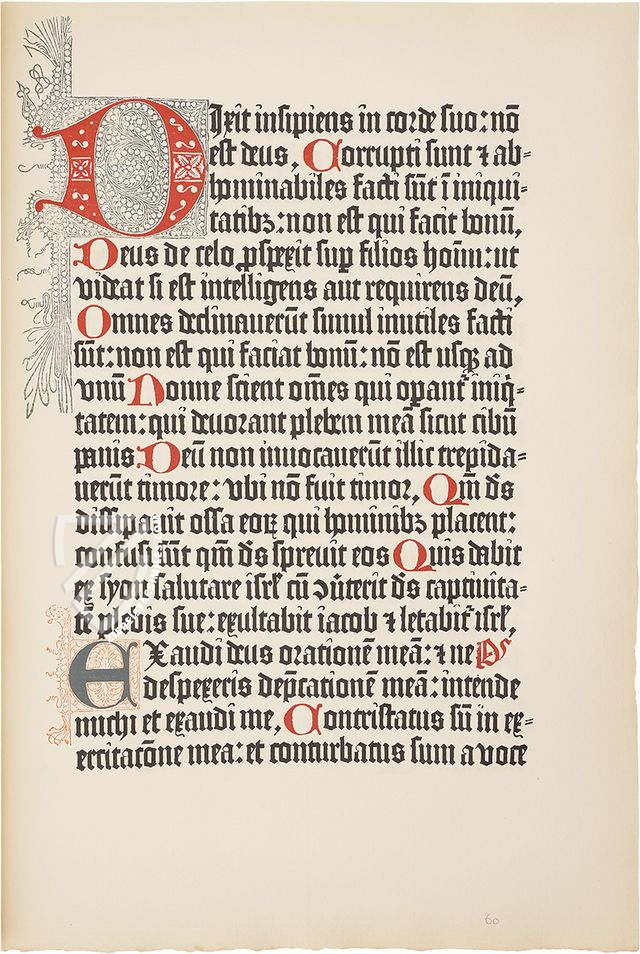
#1 Der Mainzer Psalter von 1457
Language: German
- Treatises / Secular Books
- Apocalypses / Beatus
- Astronomy / Astrology
- Bestiaries
- Bibles / Gospels
- Chronicles / History / Law
- Geography / Maps
- Saints' Lives
- Islam / Oriental
- Judaism / Hebrew
- Single Leaf Collections
- Leonardo da Vinci
- Literature / Poetry
- Liturgical Manuscripts
- Medicine / Botany / Alchemy
- Music
- Mythology / Prophecies
- Psalters
- Other Religious Books
- Games / Hunting
- Private Devotion Books
- Other Genres
- Afghanistan
- Armenia
- Austria
- Belgium
- Belize
- China
- Colombia
- Costa Rica
- Croatia
- Cyprus
- Czech Republic
- Denmark
- Egypt
- El Salvador
- Ethiopia
- France
- Germany
- Greece
- Guatemala
- Honduras
- Hungary
- India
- Iran
- Iraq
- Israel
- Italy
- Japan
- Jordan
- Kazakhstan
- Kyrgyzstan
- Lebanon
- Liechtenstein
- Luxembourg
- Mexico
- Morocco
- Netherlands
- Palestine
- Panama
- Peru
- Poland
- Portugal
- Russia
- Serbia
- Spain
- Sri Lanka
- Sweden
- Switzerland
- Syria
- Tajikistan
- Turkey
- Turkmenistan
- Ukraine
- United Kingdom
- United States
- Uzbekistan
- Vatican City
- A. Oosthoek, van Holkema & Warendorf
- Aboca Museum
- Ajuntament de Valencia
- Akademie Verlag
- Akademische Druck- u. Verlagsanstalt (ADEVA)
- Aldo Ausilio Editore - Bottega d’Erasmo
- Alecto Historical Editions
- Alkuin Verlag
- Almqvist & Wiksell
- Amilcare Pizzi
- Andreas & Andreas Verlagsbuchhandlung
- Archa 90
- Archiv Verlag
- Archivi Edizioni
- Arnold Verlag
- ARS
- Ars Magna
- ArtCodex
- AyN Ediciones
- Azimuth Editions
- Badenia Verlag
- Bärenreiter-Verlag
- Belser Verlag
- Belser Verlag / WK Wertkontor
- Benziger Verlag
- Bernardinum Wydawnictwo
- BiblioGemma
- Biblioteca Apostolica Vaticana (Vaticanstadt, Vaticanstadt)
- Bibliotheca Palatina Faksimile Verlag
- Bibliotheca Rara
- Boydell & Brewer
- Bramante Edizioni
- Bredius Genootschap
- Brepols Publishers
- British Library
- C. Weckesser
- Caixa Catalunya
- Canesi
- CAPSA, Ars Scriptoria
- Caratzas Brothers, Publishers
- Carus Verlag
- Casamassima Libri
- Chavane Verlag
- Christian Brandstätter Verlag
- Circulo Cientifico
- Club Bibliófilo Versol
- Club du Livre
- CM Editores
- Collegium Graphicum
- Collezione Apocrifa Da Vinci
- Comissão Nacional para as Comemorações dos Descobrimentos Portugueses
- Coron Verlag
- Corvina
- CTHS
- D. S. Brewer
- Damon
- De Agostini/UTET
- De Nederlandsche Boekhandel
- De Schutter
- Deuschle & Stemmle
- Deutscher Verlag für Kunstwissenschaft
- DIAMM
- Droz
- E. Schreiber Graphische Kunstanstalten
- Ediciones Boreal
- Ediciones Grial
- Ediclube
- Edições Inapa
- Edilan
- Editalia
- Edition Deuschle
- Edition Georg Popp
- Edition Leipzig
- Edition Libri Illustri
- Editiones Reales Sitios S. L.
- Éditions de l'Oiseau Lyre
- Editions Medicina Rara
- Editorial Casariego
- Editorial Mintzoa
- Editrice Antenore
- Editrice Velar
- Edizioni Edison
- Egeria, S.L.
- Eikon Editores
- Electa
- Emery Walker Limited
- Enciclopèdia Catalana
- Eos-Verlag
- Ephesus Publishing
- Ernst Battenberg
- Eugrammia Press
- Extraordinary Editions
- Fackelverlag
- Facsimila Art & Edition
- Facsimile Editions Ltd.
- Facsimilia Art & Edition Ebert KG
- Faksimile Verlag
- Feuermann Verlag
- Folger Shakespeare Library
- Franco Cosimo Panini Editore
- Friedrich Wittig Verlag
- Fundación Hullera Vasco-Leonesa
- G. Braziller
- Gabriele Mazzotta Editore
- Gebr. Mann Verlag
- Gesellschaft für graphische Industrie
- Getty Research Institute
- Giovanni Domenico de Rossi
- Giunti Editore
- Graffiti
- Grafica European Center of Fine Arts
- Guido Pressler
- Guillermo Blazquez
- Gustav Kiepenheuer
- H. N. Abrams
- Harrassowitz
- Harvard University Press
- Helikon
- Hendrickson Publishers
- Henning Oppermann
- Herder Verlag
- Hes & De Graaf Publishers
- Hoepli
- Holbein-Verlag
- Hortus Deliciarum
- Houghton Library
- Hugo Schmidt Verlag
- Idion Verlag
- Il Bulino, edizioni d'arte
- ILte
- Imago
- Insel Verlag
- Instituto Nacional de Antropología e Historia
- Istituto dell'Enciclopedia Italiana - Treccani
- Istituto Ellenico di Studi Bizantini e Postbizantini
- Istituto Geografico De Agostini
- Istituto Poligrafico e Zecca dello Stato
- Italarte Art Establishments
- J. Thorbecke
- Jan Thorbecke Verlag
- Johnson Reprint Corporation
- Josef Stocker
- Josef Stocker-Schmid
- Jugoslavija
- Karl W. Hiersemann
- Kasper Straube
- Kaydeda Ediciones
- Kindler Verlag / Coron Verlag
- Kodansha International Ltd.
- Konrad Kölbl Verlag
- Kurt Wolff Verlag
- La Liberia dello Stato
- La Linea Editrice
- La Meta Editore
- Lambert Schneider
- Landeskreditbank Baden-Württemberg
- Leo S. Olschki
- Les Incunables
- Library of Congress
- Libreria Musicale Italiana
- Lichtdruck
- Lito Immagine Editore
- Lumen Artis
- Lund Humphries
- M. Moleiro Editor
- Maison des Sciences de l'homme et de la société de Poitiers
- Manuscriptum
- Martinus Nijhoff
- Maruzen-Yushodo Co. Ltd.
- MASA
- McGraw-Hill
- Militos
- Millennium Liber
- Müller & Schindler
- Nahar and Steimatzky
- National Library of Wales
- Neri Pozza
- Nova Charta
- Oceanum Verlag
- Odeon
- Orbis Mediaevalis
- Orbis Pictus
- Österreichische Staatsdruckerei
- Oxford University Press
- Pageant Books
- Parzellers Buchverlag
- Patrimonio Ediciones
- Pattloch Verlag
- PIAF
- Pieper Verlag
- Plon-Nourrit et cie
- Prestel Verlag
- Princeton University Press
- Prisma Verlag
- Priuli & Verlucca, editori
- Pro Sport Verlag
- Propyläen Verlag
- Pytheas Books
- Quaternio Verlag Luzern
- Reales Sitios
- Recht-Verlag
- Reichert Verlag
- Reichsdruckerei
- Riehn & Reusch
- Roberto Vattori Editore
- Rosenkilde and Bagger
- Roxburghe Club
- Salerno Editrice
- Sarajevo Svjetlost
- Schöck ArtPrint Kft.
- Schulsinger Brothers
- Scolar Press
- Scrinium
- Scripta Maneant
- Scriptorium
- Shazar
- Siloé, arte y bibliofilia
- SISMEL - Edizioni del Galluzzo
- Sociedad Mexicana de Antropología
- Société des Bibliophiles & Iconophiles de Belgique
- Soncin Publishing
- Sorli Ediciones
- Stainer and Bell
- Studer
- Styria Verlag
- Sumptibus Pragopress
- Szegedi Tudomànyegyetem
- Taberna Libraria
- Tarshish Books
- Taschen
- Tempus Libri
- Testimonio Compañía Editorial
- Thames and Hudson
- The Clear Vue Publishing Partnership Limited
- The Facsimile Codex
- The Folio Society
- The Marquess of Normanby
- The Richard III and Yorkist History Trust
- Tip.Le.Co
- TouchArt
- TREC Publishing House
- TRI Publishing Co.
- Trident Editore
- Typis Regiae Officinae Polygraphicae
- Union Verlag Berlin
- Universidad de Granada
- University of California Press
- University of Chicago Press
- Urs Graf
- Vallecchi
- Van Wijnen
- VCH, Acta Humaniora
- VDI Verlag
- VEB Deutscher Verlag für Musik
- Verlag Anton Pustet / Andreas Verlag
- Verlag Bibliophile Drucke Josef Stocker
- Verlag der Münchner Drucke
- Verlag für Regionalgeschichte
- Verlag Styria
- Vicent Garcia Editores
- W. Turnowski Ltd.
- W. Turnowsky
- Waanders Printers
- Wiener Mechitharisten-Congregation (Wien, Österreich)
- Wissenschaftliche Buchgesellschaft
- Wissenschaftliche Verlagsgesellschaft
- Wydawnictwo Dolnoslaskie
- Xuntanza Editorial
- Zakład Narodowy
- Zollikofer AG

